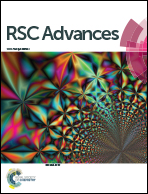Surface-enhanced Raman scattering (SERS) detection of fluorosurfactants in firefighting foams†
Abstract
We demonstrated SERS (surface-enhanced Raman scattering) detection of fluorosurfactants (FSs), which are commonly formulated in aqueous firefighting foams (AFFFs), by increasing their loading affinity and boosting their Raman activity. In order to increase FS's loading affinity, we introduced a cationic dye (ethyl violet or methyl blue) into the aqueous incubation solution to co-precipitate the FS onto the SERS substrate surface by forming an immiscible ion-pair (dye–FS). In the meantime, the Raman signal intensity was boosted due to the much higher Raman activity of the dye than that of FS. We compared two kinds of SERS substrate, patterned silver (Ag) surface and graphene oxide (GO) membrane, and noted the former (dye–FS–Ag) enhanced the Raman signal whilst the latter (dye–FS–GO) increased the loading affinity of the ion-pair due to the hydrophobic surface. We thus introduced silver nanoparticles (AgNPs) into the incubation solution (as well as dye) to co-precipitate FS onto the GO surface via an assembly of dye–FS–AgNP–GO. Using this assembly, we successfully detected FSs including pentadecafluorooctanoic acid (PFOA), perfluorooctanesulfonic acid (PFOS), and 1H,1H,2H,2H-perfluorooctanesulfonic acid (6:2FTS), with a limit-of-detection (LOD) of ∼50 ppb (∼120 nM) for PFOA.


 Please wait while we load your content...
Please wait while we load your content...